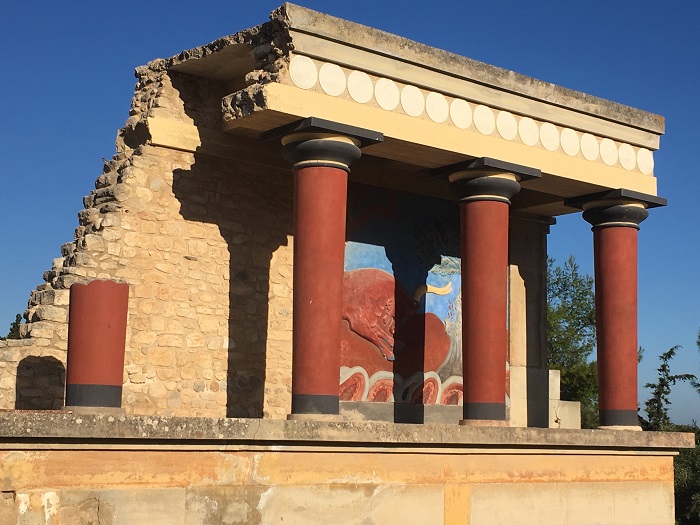
Join Thor and me for an introduction to the reconstructed Minoan site of Knossos, with some peeks at related treasures in the Iraklion Museum of Archaeology.
NOTE: Of course, Thor and I had to make another trip to Greece, as he’s fallen as much in love with the islands as I am. This time, in addition to other island-hopping, I wanted to return to Crete after 37 years. My first months-long trip was as a hippie backpacker, camping in the ruins and falling under the spell of the mysterious, vanished Minoan culture. This time, I got to introduce Thor to “glorious Kriti” and research more settings for my novel-in-progress, THE ARIADNE DISCONNECT. This new blog series started October 19, 2019, and will continue every Saturday.
After a quick trip to the archaeology museum after our arrival in Iraklion (they kicked us out at closing time), Thor and I had a better sense of context for our early-morning visit to ancient Knossos. Then we had time to return to the museum in the afternoon and really absorb the amazing contents arranged historically, the finest collection of Minoan artifacts in the world (naturally, here on Crete). In this overview, we’ll accordingly hop back and forth from site to museum artifacts. Upcoming blog posts will delve into more details, so hang on….
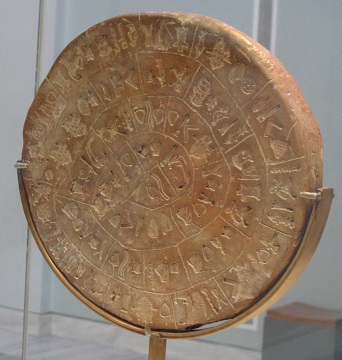
Like the mysterious and so-far-indecipherable Phaistos Disk, the history of the Minoans (or Keftiu) is tantalizingly speculative. Their Linear A script has not been translated, and there are few historical references except from later Greek historians/storytellers and myths. Most of what we know comes from excavations and interpretations of architecture, burial sites, frescoes, abundantly traded pottery, and other art. The general consensus is that they were a peaceful society that celebrated nature and successfully traded goods across the Aegean. Women were apparently equal with men (very unusual in any culture!), and especially honored as priestesses. The people built labyrinthine palace/city structures, but suffered from serial earthquakes and the catastrophic tidal wave from the eruption of Thira (Santorini), after which their influence waned.
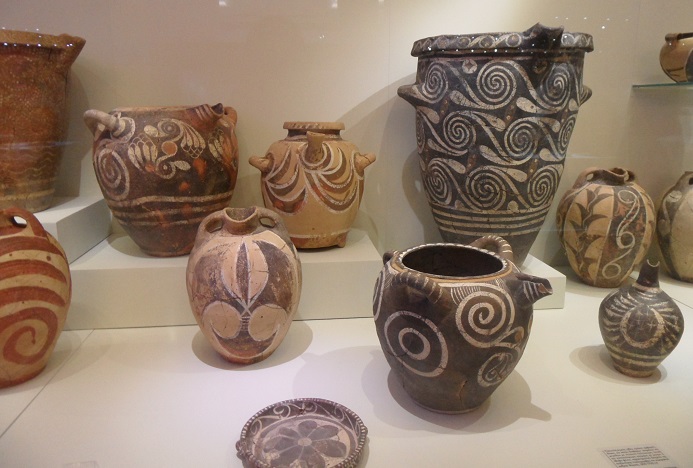
Scholars define the Minoan Bronze Age culture as stretching from 2700 to 1100 BC, on the islands of Crete and Thira (Santorini). Knossos was the biggest of their fabled 90 or 99 cities, referenced many hundreds of years later by Greek epic poet Homer. The Minoans and their cities later were relegated to the status of myth until Sir Arthur Evans bought the rubble-strewn site of Knossos in the early 1900s and excavated an astonishing palace complex. Although his reconstructions are considered controversially-styled by current archaeologists, it’s a wonderful experience to wander the partially-reconstructed labyrinth for a visceral understanding of the spaces these vanished people inhabited.
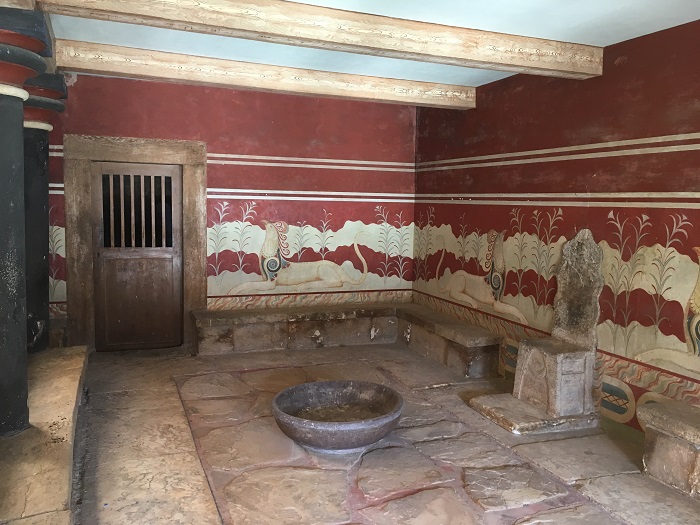
From my journal: “The site, like Phaistos [see previous blog post], feels peaceful and nurturing. Everything here — the labyrinth of rooms and brightly reproduced frescoes — all seems joyful and nature-loving. Dolphins! Flowers! Blue monkeys picking saffron!”
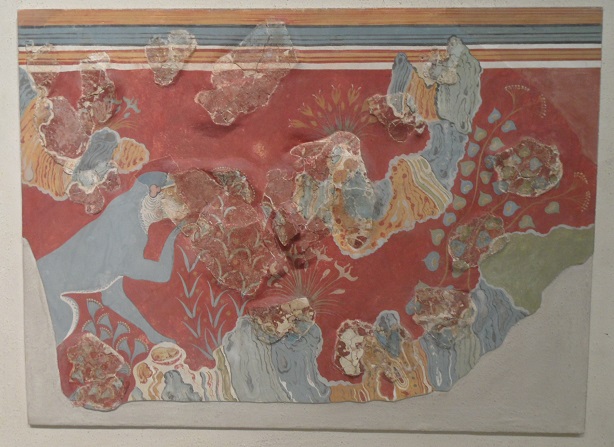
Luckily we were early enough to beat the tourist hordes from the buses, so we could wander and enjoy.
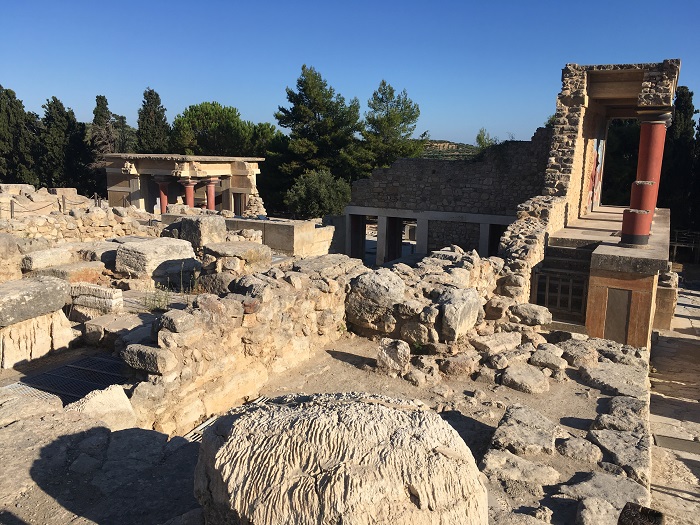
The importance of the sea to these islanders is reflected in the famous dolphin fresco. (All the frescoes onsite are reproductions.)
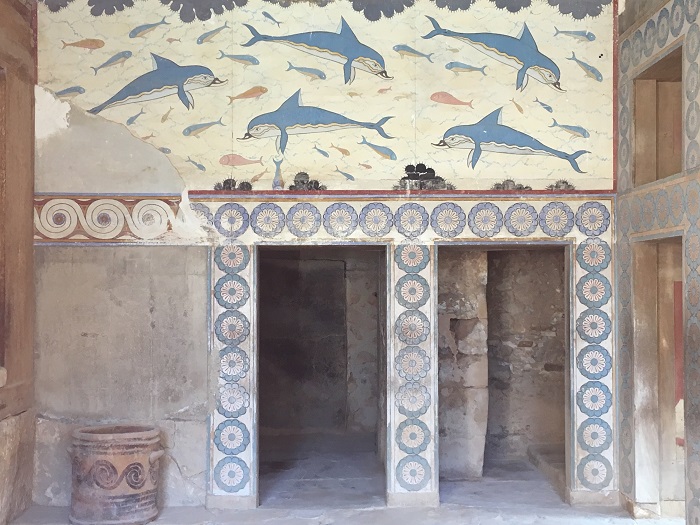
Fragments of the original in the museum reveal how surprisingly little of the actual frescoes can lead to extrapolation of the whole design. Here is some detail of the original mural. Because of the technique and dyes used, the original colors were luckily preserved in the many frescoes unearthed on the island.
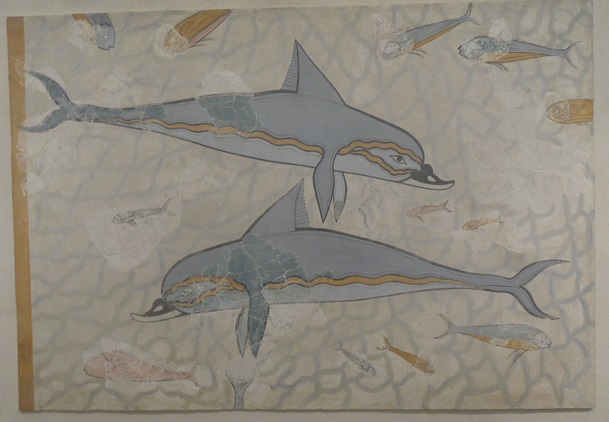
The story of King Minos (for whom Evans named the Minoans) and his labyrinth of Knossos became a myth of the later mainland Greeks. According to the story, Minos angered Poseidon (which god the Minoans almost certainly did not have, as Poseidon belonged to the later Greek Olympian pantheon) by refusing to sacrifice to the god a sacred white bull that Poseidon had sent to Crete. Poseidon angrily cursed Minos by making his wife fall in love with a bull, which impregnated her. Thus was born the Minotaur, a monstrous human with a bull’s head. (Below is a later Greek vessel with the Minotaur.)
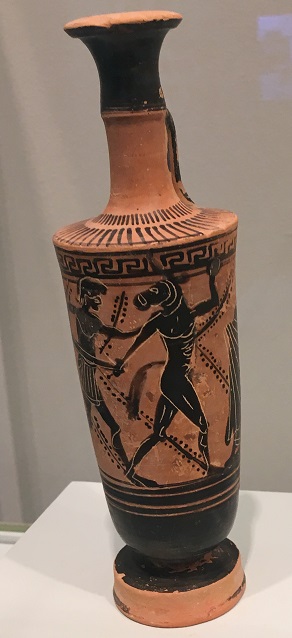
Minos imprisoned the Minotaur at the center of his labyrinth, which some identify with the mazelike palace of Knossos. Supposedly Crete, dominating trade in the Aegean, demanded sacrifices of mainland youths to feed the monster. At any rate, sacred bulls and their horns were important symbols to the Minoans. On entering Knossos, we first saw the recreated Horns of Consecration embracing a view of the distant sacred hills.
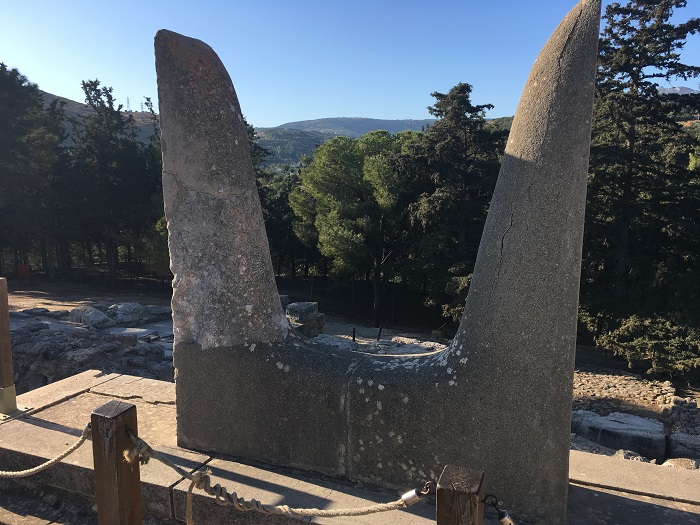
Apparently such horns were a common feature atop buildings, like this limestone example in the museum.
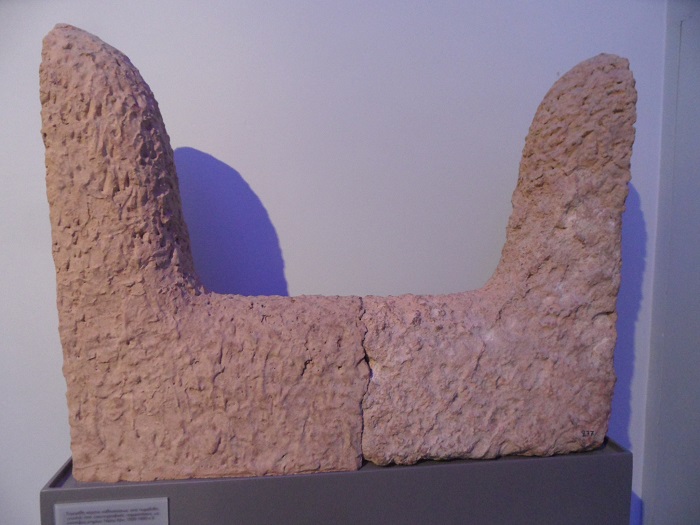
This dramatic bull fresco decorates a central structure:

There’s also a reproduced fresco of the famous bull-leaping, in which young athletes of both genders vaulted over one of the sacred bulls.
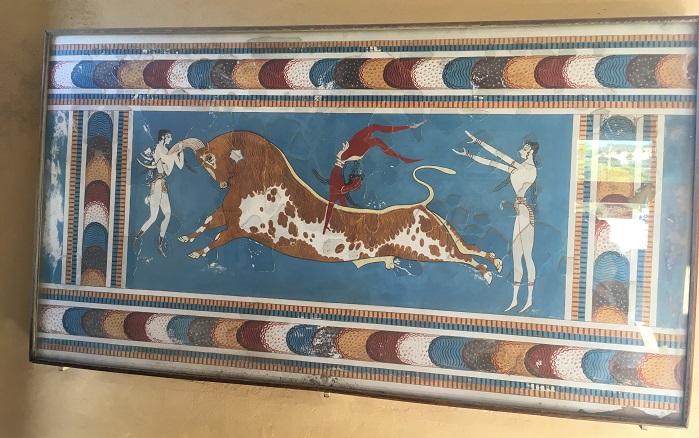
One of the special treasures of the museum is the bull-head rhyton (drinking vessel) of stone with inlaid ivory and semi-precious stones. Wine could be poured into a hole in the back of the neck, then poured out through the nostrils.
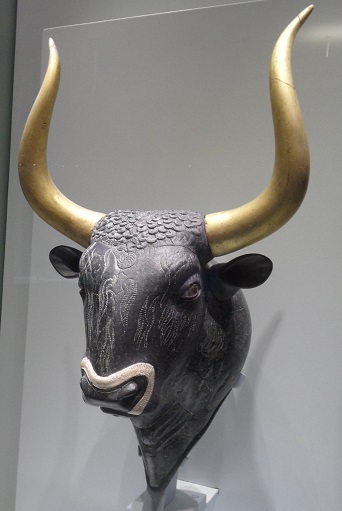
As mentioned above, princess Ariadne may have been the priestess of the Knossos labyrinth. When Theseus from Athens came to kill the Minotaur and end the sacrifices, Ariadne gave him a thread to find his way back from the center.
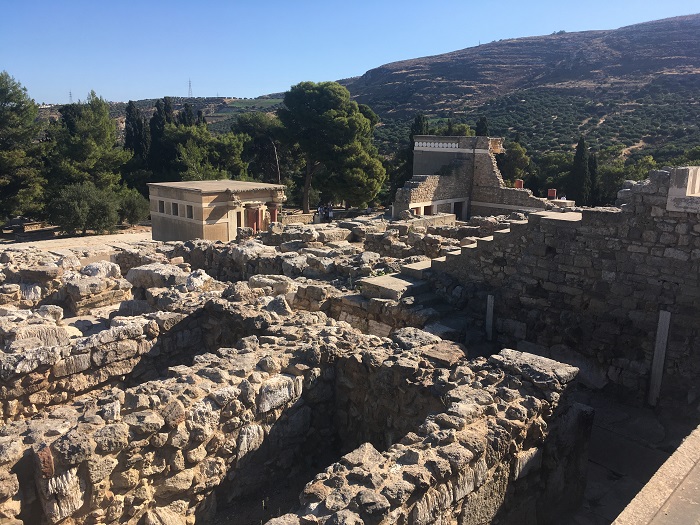
This model of the ancient palace complex, in the museum, really helps in visualizing the complexity of the structure that led to its identification as the labyrinth:

Women were apparently honored as priestesses and as powerful members of the upper classes. (They also seem to have participated equally with men in the working-class jobs.) There are images of a goddess, often pictured floating down from the sky, but no images of gods. This gold seal-ring, dubbed the Ring of Minos, features three different images of the goddess, along with some lesser figures:
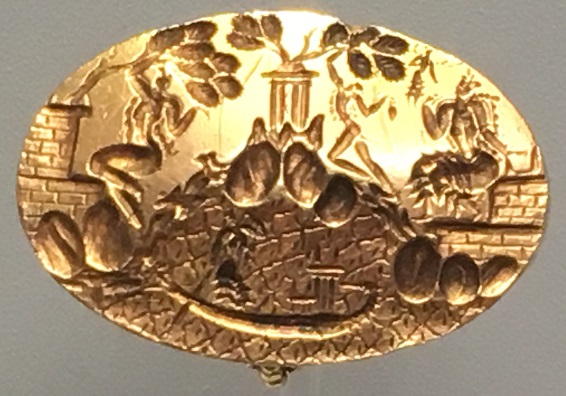
One of my favorite artifacts in the museum (I fell in love with it on my first trip decades ago) is this figurine of the serpent goddess or priestess. Later Greeks came to identify the serpent priestess with Ariadne, and some speculated that the Cretan goddess later evolved into the Olympian goddess Athena.
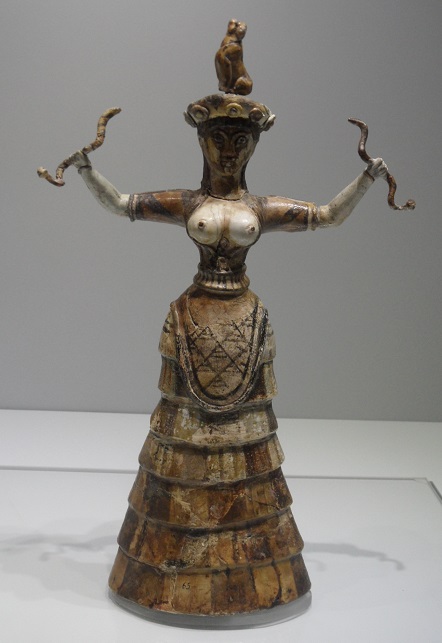
The sacred serpents were revered as holding powers of regeneration and mysteries of the earth. The snake priestess could harness and channel that power, just as my reluctant healer Ariadne does in my near-future Greek islands novel. Some powers endure….
*****
You will find The Rambling Writer’s blog posts here every Saturday. Sara’s latest novel from Book View Cafe is available in print and ebook: The Ariadne Connection. It’s a near-future thriller set in the Greek islands. “Technology triggers a deadly new plague. Can a healer find the cure?” The novel has received the Chanticleer Global Thriller Grand Prize and the Cygnus Award for Speculative Fiction. Sara has recently returned from another research trip in Greece and is back at work on the sequel, The Ariadne Disconnect. Sign up for her quarterly email newsletter at www.sarastamey.com

1 thought on “The Rambling Writer Returns to Crete, part 11: Knossos and Archaeological Treasures”